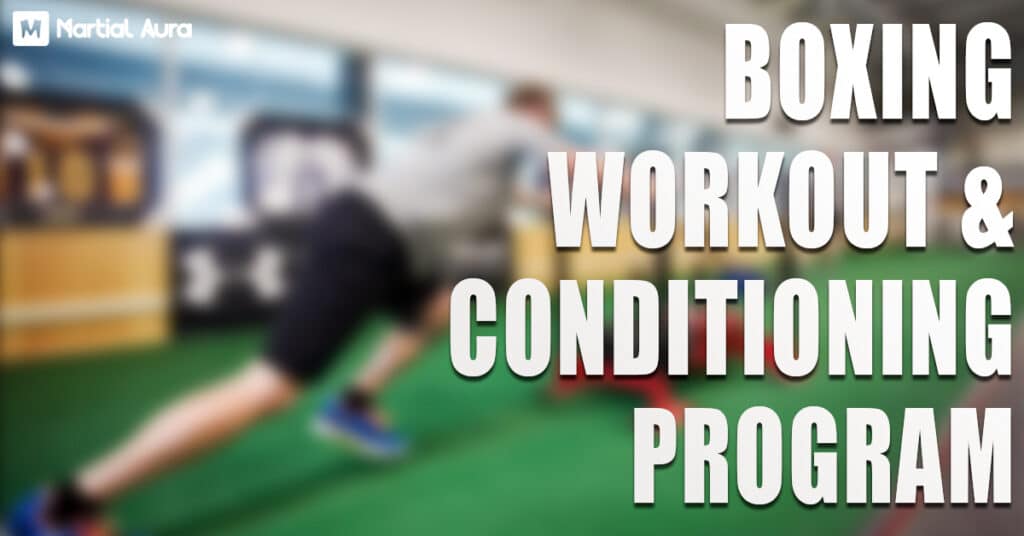Achieving a fighter physique requires dedication, discipline, and a well-designed boxing workout and conditioning program. Boxing is one of the most effective workouts for building endurance, strength, and agility while providing a high level of boxing fitness and mental resilience. In this guide, we’ll break down each component of boxing conditioning, covering techniques, drills, workout plans, and much more.
Benefits of a Boxing Workout and Conditioning Program

Boxing workouts focus on multiple aspects of fitness, blending cardio, strength, and speed to create a full-body workout that builds power and endurance. This combination helps develop the athlete physique while enhancing mental toughness. Let’s dive into some key benefits.
Why Boxing Is an Effective Full-Body Workout
- Cardio Power: Boxing is a high-intensity sport that raises the heart rate quickly, improving cardiovascular health and endurance.
- Strength and Muscle Toning: Boxing utilizes body and sometimes light weights to build functional strength.
- Coordination and Agility: Boxing drills improve hand-eye coordination, footwork, and speed.
- Stress Relief: Hitting a bag or working through a combination can help reduce stress levels while increasing focus.
Whether you’re aiming to develop a boxer physique or simply want to achieve peak fitness, a structured boxing workout can help you meet your fitness goals.
Essential Boxing Gear for Beginners

Having the right equipment is crucial when starting your boxing conditioning program. Here’s a list of essential and optional gear you may need.
| Equipment | Purpose |
|---|---|
| Boxing Gloves | Protects hands and wrists |
| Hand Wraps | Adds wrist stability and knuckle padding |
| Heavy Bag | Builds power and accuracy through punches |
| Speed Bag | Improves hand-eye coordination |
| Jump Rope | Enhances footwork and cardiovascular fitness |
Optional Equipment:
- Focus Mitts: Helps improve accuracy and reaction time during boxing drills.
- Agility Ladder: Enhances foot speed, which is essential for staying light on your feet.
- Resistance Bands: Adds resistance to various movements, ideal for boxing strength training.
Boxing Basics: Stance, Footwork, and Terminology

Understanding boxing fundamentals is the first step to mastering the sport. Proper stance, footwork, and basic punches are foundational for effective training.
Boxing Stance and Footwork
- Orthodox Stance: Used by right-handed boxers, with the left foot forward.
- Southpaw Stance: Used by left-handed boxers, with the right foot forward.
Footwork Techniques:
- Shuffle: Moving forward, backward, or sideways without crossing your feet.
- Pivot: A rotational movement on the ball of the front foot, useful for repositioning.
Good footwork provides balance and sets up offensive and defensive moves, allowing fighters to stay in control of the ring.
Common Boxing Terms
- Combination: A sequence of punches, often blending various types of punches.
- Slip: Moving your head to the side to avoid a punch.
- Counterpunch: A defensive punch thrown immediately after an opponent’s strike.
- Guard: A defensive hand position to block incoming punches.
Punching Techniques: Mastering the Fundamentals

Boxing relies on mastering different types of punches, each with a specific purpose and technique. Learning proper punch form can improve both power and speed while minimizing the risk of injury.
Basic Types of Punches
- Jab: A quick, straight punch often used to keep opponents at a distance.
- Cross: A powerful punch with the rear hand, used for offensive attacks.
- Hook: A punch thrown from the side, ideal for body shots or targeting the opponent’s head.
- Uppercut: An upward punch, often used at close range for maximum impact.
Using the right punch at the right moment is key to landing effective combinations and scoring points. Practicing these punches also enhances coordination and timing, essential for boxing success.
Building Strength and Conditioning for Boxing

Strength is a major component of boxing, as it allows fighters to generate force and absorb impact. Boxing strength and conditioning workouts focus on functional strength, explosive power, and muscular endurance.
Strength Training for Boxers
Does boxing build muscle? Yes, although boxing focuses more on lean muscle and tone rather than bulk. Here are some exercises to include:
- Bodyweight Exercises: Push-ups, pull-ups, and dips for upper-body strength.
- Core Workouts: Russian twists, planks, and leg raises to build core stability.
- Light Resistance Training: Dumbbell or kettlebell exercises can increase power without adding bulk.
Incorporating these exercises into a boxing conditioning program helps boxers maintain strength and endurance throughout multiple rounds.
Conditioning Drills for Endurance
Boxing requires intense cardio conditioning to handle the fast pace and continuous movement. Some effective conditioning drills include:
- Interval Training: Alternating between high-intensity exercises and short rests, similar to a boxing round.
- Heavy Bag Workouts: Hit the heavy bag in 3-minute intervals with a 1-minute rest to mimic the structure of a boxing match.
- Sprints: Short bursts of speed are excellent for building explosive endurance, ideal for fighters.
Weekly Boxing Workout Plan for Peak Performance

A well-structured training schedule for boxing helps you balance skill, conditioning, and strength work. Here’s a sample weekly boxing workout plan.
| Day | Focus | Exercises |
|---|---|---|
| Monday | Technique & Drills | Shadowboxing, jab-cross-hook combinations, footwork drills |
| Tuesday | Strength & Conditioning | Bodyweight circuits, core workouts, agility ladder |
| Wednesday | Boxing Skills | Heavy bag rounds, mitt work, head movement drills |
| Thursday | Conditioning | Sprint intervals, jump rope, heavy bag intervals |
| Friday | Sparring Practice | Light sparring rounds, defensive drills, counterpunch practice |
| Saturday | Rest & Recovery | Light stretching, yoga, foam rolling |
| Sunday | Technique & Form | Shadowboxing, stance adjustments, focus on form |
This balanced schedule combines technique, strength, and conditioning for a comprehensive boxing workout plan.
Diet and Recovery Tips for Boxers

Boxing requires both physical and mental strength, which is heavily influenced by diet and recovery practices. Proper nutrition and adequate rest can greatly impact your performance and recovery.
Diet Tips for Boxing Training
- Protein: Essential for muscle recovery, with lean meats, fish, eggs, and plant proteins being great sources.
- Carbohydrates: Provides energy, especially from complex sources like whole grains and fruits.
- Fats: Healthy fats from sources like avocados, nuts, and olive oil provide sustained energy.
Recovery Techniques
- Rest Days: Essential for recovery, allowing muscles to repair and grow.
- Stretching: Improves flexibility and reduces muscle tension.
- Sleep: A minimum of 7-8 hours per night helps muscle recovery and mental clarity.
A solid recovery routine helps prevent injuries and ensures you’re ready for the next workout.
Advanced Boxing Drills for Conditioning and Skill Development

As you progress in your boxing workout and conditioning program, incorporating advanced drills can enhance your performance.
Advanced Conditioning Drills
- Heavy Bag with Footwork: Move around the bag while executing punches, simulating a real fight.
- Plyometric Exercises: Box jumps, burpees, and explosive push-ups develop speed and power.
- Partner Drills: Working with a partner on focus mitts improves reflexes, timing, and accuracy.
These advanced drills add variety to your workout while enhancing boxing skills and conditioning.
Boxing Jargon and Terminology Every Boxer Should Know

Learning boxing terminology is essential for communicating effectively in the gym and understanding instructions from coaches. Here are some key terms:
- Feint: A fake punch or movement to mislead the opponent.
- Slip: Moving the head slightly to avoid a punch.
- Counterpunch: A punch thrown directly after the opponent’s punch, aiming to catch them off guard.
- Ring Generalship: The skill of controlling the fight’s pace and positioning.
Understanding these boxing terms and techniques can help new boxers feel more confident in their training environment.
Wrapping Up Your Boxing Conditioning Journey
The boxing workout and conditioning program outlined in this guide is designed to help you reach peak fitness. By incorporating a mix of strength, conditioning, and technique-focused exercises, you’ll achieve not only the athlete physique but also the skills and stamina of a professional boxer. Stick to a workout plan that includes drills, conditioning, and recovery, and you’ll be well on your way to mastering the art of boxing.

James Wesley is a passionate martial arts enthusiast and the voice behind Martial Aura. With a deep love for UFC and combat sports, he shares expert insights and in-depth analysis on everything from fight strategies to athlete profiles. When he’s not writing, you’ll find him training or watching the latest fights, always learning from the best in the ring.






